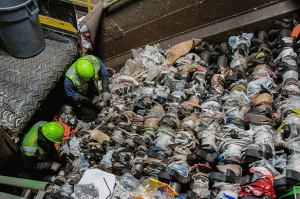I imagine most of us at some point in our Toward Zero Waste journey have ended up standing in front of the waste bins wondering if what we have in our hands is truly recyclable–I mean it has a recycling symbol on it so it has to be right?!? From clamshell containers to ‘compostable’ cups, decisions of what goes where is confusing. Once you’ve subscribed to the idea that you are going to do all you can to divert items from the landfill, you just don’t want to toss it out if it might be recyclable…but that means at some point you’ve probably done it: Wishful Recycling.
We discussed recycling and contamination at some length in a breakout session at the recent Washington State Recycling Association Conference held right here in Whatcom County at the lovely Semiahmoo Resort and Spa. Unfortunately, at present there aren’t any easy answers, and China’s new limits on what they will accept for recycling is not the problem (more on that in an upcoming blog). During the workshop we identified many issues that contribute to wishful recycling, but you are probably wondering ‘What’s the big deal?’ and ‘Wouldn’t it be better to capture all the possible recyclables we can?’ The short answer is no. The waste professional adage “when in doubt, throw it out” holds true and here is why.
In Whatcom County, we source separate at the curb when we put our recycling out, and for the most part individual households are pretty good at it, and our contamination rate is pretty low. But things change drastically in public places, instances where waste space is shared, and also in the business sector, and it is estimated that 25% of what is put in recycling containers in these cases is actually not recyclable. Yes, one of four items put in the recycle bin doesn’t belong there.

Complete shutdown – A recycling sorter shut down to remove contaminants, mainly plastic bags, that stop the machine from working properly.
So, what is the number one problem with wishful recycling? It costs money. Contamination significantly increases the cost to process recyclables and makes it harder for processors to market their products, creating a huge economic challenge. We rely on the private sector to take away our waste and they need to be able to turn a profit in order to run a viable business.
Contaminating a waste stream can also render a whole load of material worthless. For example, a couple of half full juice containers ending up in a bin of mixed paper break during processing and the entire load of paper is saturated with liquid, is unsalable, and is now destined for landfill. Now imagine all the other items that contaminate a waste stream from synthetic textiles to coated papers and you start getting an idea of the depth of the problem.
Back to our discussion on contamination, we all danced around the elephant in the room for a while at the Recycling Conference. We eventually talked about said elephant–we just create too much stuff with no mind paid to where it will end up. From packaging to single-use disposable items, it is clear the recycling systems we have in place need a break from the ever increasing and more contaminated recycling loads. In order to really move the needle, we need to concentrate on source reduction–a large and complex problem. But, in the meantime, we need to keep our recycling stream as clean as possible and ditch our wishful recycling habits, get educated about what you can/cannot recycle, look for ways to reduce what we consume in the first place, and when in doubt, throw it out!
To refresh on current recycling (and composting) collection details, you can visit Sanitary Services Company’s website, Nooksack Valley Disposal & Recycling, and Green Earth Technology (our local commercial composting company).
